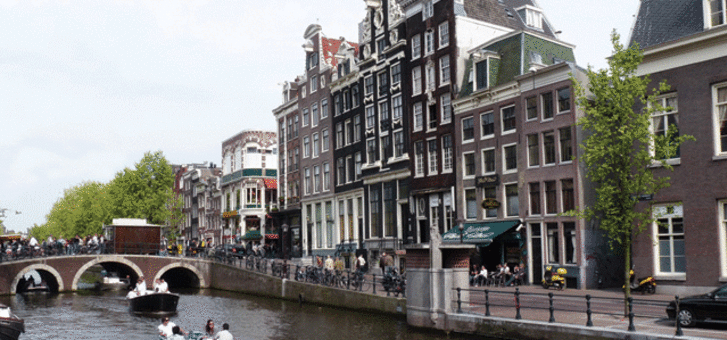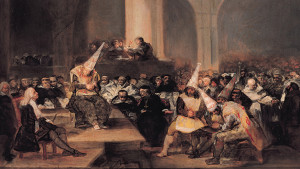Oppression, coercion and persecution: all of these words refer to the domination of others and go against the Universal Declaration of Human Rights.
We abhor such actions, whether they be politically, racially or religiously based. The rights of any person cannot and should not conflict with those of others. It’s been said that “your right to swing your fists ends where my nose begins”! No country or belief system has any legitimacy in enforcing its beliefs in ways that violate the rights of others. The right of the individual for freedom is paramount.
Unfortunately, whether you consider Burma and its oppression of Buddhist priests or Afghanistan and Pakistan and the enforcement of strict sharia law, those with opposite views have often been suppressed, and when that happens, individual freedom vanishes.
A brief history of Amsterdam
Religious statues related to
Catholic worship can be found
throughout the museum.
Stories of oppression, coercion and persecution are not new. One example is the city of Amsterdam in the Netherlands, which has a recent history of liberal thinking and government but farther back, a darker history of persecution.
Amsterdam was overwhelmingly Roman Catholic in belief and practice until around 1578. Prior to 1578, the nation of Holland boasted many Catholic monasteries, large churches and a number of chapels. However, like many other cities and countries of Europe in the sixteenth century, the Reformation spread and Amsterdam became Dutch Reformed and Protestant.
This was partly a reaction to the Spanish Inquisition, which started in the late 1400s. In an attempt to maintain Catholic orthodoxy in Spain, Jews and Muslims were ordered to convert or leave. Those who refused to renounce their Jewish or Islamic beliefs and who remained, faced the constant threat of death. Because Holland was a Spanish colony at the time, thousands of Dutch people perished.
On May 26, 1578, the city fathers, who were all Calvinists by then, passed a resolution called the “Alteration” that outlawed Catholic churches and religious orders. Catholic priests were removed from the city and Catholic churches were handed over to become Protestant churches. Most of these Protestant churches were the Dutch Reformed Church, which had links to John Calvin, but other churches of the Reformed faith were also represented. The Beguines, a Roman Catholic lay religious community composed of women who sought to serve God, were forbidden to wear their distinctive uniforms as they tended to the sick and dying in the city. Their church was closed in 1578; then it was handed to English Calvinists in 1607.
For years, the Catholic Church had persecuted the Protestants and now similar acts were directed toward the Catholics. Protestant ministers were diligent in notifying the city authorities of any so-called idolatrous or popish practices they observed. However, they were not entirely successful
The Museum Amstelkring
The focus of this “secret” Catholic church in the museum of Our Lord in the Attic is this altar. The museum is located on one of Amsterdam's many canals.
In Amsterdam, there is a museum with a difference, that’s worth the time to visit, that reflects those times. It claims to be the second oldest museum in a city that has many museums. The Museum Amstelkring is situated on the Oudezijds Voorburgwal canal, not far from Central Station.
Around 1661, Jan Hartman, a rich merchant, bought three houses. One faced the canal and the other two were around the corner. He and his family lived in the front rooms of the house fronting the canal.
Hartman converted the attic of this house and its adjoining houses into a church for Catholic worship, which probably explains why the museum is also called “Our Lord in the Attic.”
Small groups of Catholics met there for worship; this was made possible by sympathetic city authorities, especially when they were offered bribes. As long as the meetings were in secret, they were permitted. Such secret church meetings also took place among the Catholic women mentioned.
Today, the Museum Amstelkring is visited by thousands. The museum includes great religious paintings, a crucifix in gold, candles, images of the saints and the gilt monstrance (a Catholic vessel used to display the consecrated Eucharistic host for adoration). Many silver items are also shown, from incense holders to places for holy water.
The greatest lesson this museum should teach us is tolerance and the individual rights of everyone, regardless of their religions or creeds. We all need to remind ourselves of the lessons of the past, for we either learn from history or repeat it.
Despite knowing the effects of Catholic persecution, Protestants, once they gained power in different parts of Europe, set about enforcing their beliefs and worship forms on Catholics as well as on other Protestants with whom they disagreed.
Zwingli, who led the Protestant Reformation in Zurich, Switzerland, turned the tables on the Anabaptists, torturing them and drowning them in the Limmat River. England saw the tables turned from Protestant to Catholic with the ascension of Queen Mary, who gained the notorious title “Bloody Mary” because of the large number of people she executed because of their religious persuasion. But when the Protestants returned to power, the table tilted the other way!
Even today, across the world, we see and hear of Christians and Muslims in Africa, Indonesia and other countries fighting and opposing those whose worship is different from theirs.
How much happier would the world be if we all cherished the rights enshrined in the United Nation’s Universal Declaration of Human Rights. Wars in the name of religion would be a thing of the past. Oppression, coercion and persecution would be seen as the text of history lessons.
It sounds like it could be heaven come to earth!
Persecution by Protestants
Much has been made about the persecution of so-called heretics by the Catholic Church during the Middle Ages. However, Protestants have not been immune to the maxim that “power tends to corrupt, and absolute power corrupts absolutely.”
John Calvin (pictured left), an influential French theologian and pastor during the Protestant Reformation, was willing to allow Spanish theologian, physician, cartographer and humanist Michael Servetus to be burned at the stake as a heretic because he did not believe in the divinity of Jesus Christ.
While Reformation leader Martin Luther believed that religious freedom was granted to kings and princes, he claimed that the peasant class was expected to follow their prince in the matter of religion. Thus, Luther and his followers dealt harshly with priests who differed with them regarding Luther’s teachings about biblical doctrines.
The Pilgrim Fathers, who escaped persecution in England, ironically ran their new colony with an iron hand that brooked no freedom for others. Any dissenters were banished, and occasionally some were executed for their faith.





